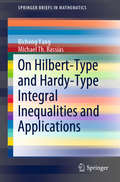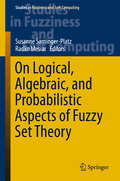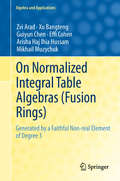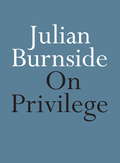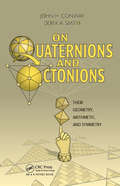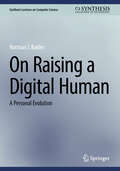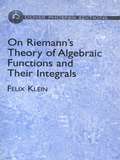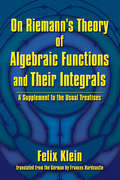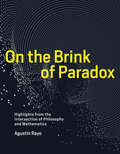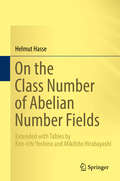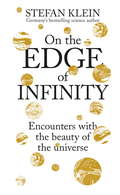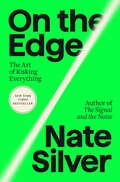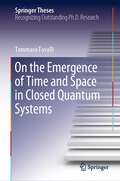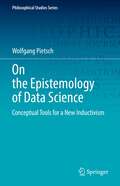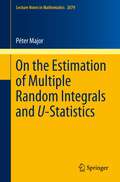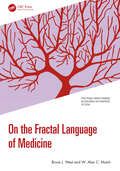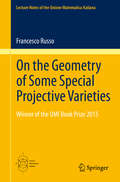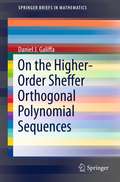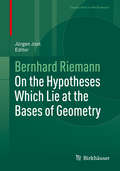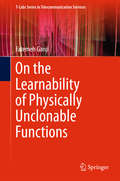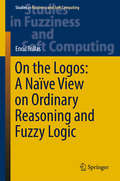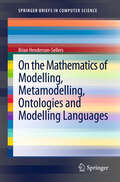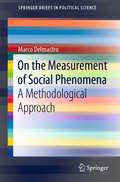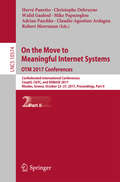- Table View
- List View
On Hilbert-Type and Hardy-Type Integral Inequalities and Applications (SpringerBriefs in Mathematics)
by Michael Th. Rassias Bicheng YangThis book is aimed toward graduate students and researchers in mathematics, physics and engineering interested in the latest developments in analytic inequalities, Hilbert-Type and Hardy-Type integral inequalities, and their applications. Theories, methods, and techniques of real analysis and functional analysis are applied to equivalent formulations of Hilbert-type inequalities, Hardy-type integral inequalities as well as their parameterized reverses. Special cases of these integral inequalities across an entire plane are considered and explained. Operator expressions with the norm and some particular analytic inequalities are detailed through several lemmas and theorems to provide an extensive account of inequalities and operators.
On Logical, Algebraic, and Probabilistic Aspects of Fuzzy Set Theory
by Radko Mesiar Susanne Saminger-PlatzThe book is a collection of contributionsby leading experts, developed around traditional themes discussed at the annualLinz Seminars on Fuzzy Set Theory. The different chapters have been written byformer PhD students, colleagues, co-authors and friends of Peter Klement, aleading researcher and the organizer of the Linz Seminars on Fuzzy Set Theory. The book also includes advanced findings on topics inspired by Klement'sresearch activities, concerning copulas, measures and integrals, as well asaggregation problems. Some of the chapters reflect personal views andcontroversial aspects of traditional topics, while others deal with deepmathematical theories, such as the algebraic and logical foundations of fuzzyset theory and fuzzy logic. Originally thought as an homage to Peter Klement,the book also represents an advanced reference guide to the mathematicaltheories related to fuzzy logic and fuzzy set theory with the potential tostimulate important discussions on new research directions in the field.
On Normalized Integral Table Algebras (Fusion Rings)
by Arisha Haj Ihia Hussam Mikhail Muzychuk Zvi Arad Effi Cohen Guiyun Chen Xu BangtengThe theory of table algebras was introduced in 1991 by Z. Arad and H. Blau in order to treat, in a uniform way, products of conjugacy classes and irreducible characters of finite groups. Today, table algebra theory is a well-established branch of modern algebra with various applications, including the representation theory of finite groups, algebraic combinatorics and fusion rules algebras. This book presents the latest developments in this area. Its main goal is to give a classification of the Normalized Integral Table Algebras (Fusion Rings) generated by a faithful non-real element of degree 3. Divided into 4 parts, the first gives an outline of the classification approach, while remaining parts separately treat special cases that appear during classification. A particularly unique contribution to the field, can be found in part four, whereby a number of the algebras are linked to the polynomial irreducible representations of the group SL3(C). This book will be of interest to research mathematicians and PhD students working in table algebras, group representation theory, algebraic combinatorics and integral fusion rule algebras.
On Privilege (Little Books On Big Themes Ser.)
by Julian BurnsideRenowned barrister, ethicist and human rights advocate Julian Burnside QC's grandparents lived in a world of handsome cars, elegant tennis parties and coiffed women. As a five-year-old, he saw privilege before he heard the word or learned its meaning. In this powerful broadside that takes in politicians and infamous legal cases, Julian Burnside explores the concept of privilege and the people who have it.
On Quaternions and Octonions
by John H. Conway Derek A. SmithThis book investigates the geometry of quaternion and octonion algebras. Following a comprehensive historical introduction, the book illuminates the special properties of 3- and 4-dimensional Euclidean spaces using quaternions, leading to enumerations of the corresponding finite groups of symmetries. The second half of the book discusses the less f
On Raising a Digital Human: A Personal Evolution (Synthesis Lectures on Computer Science)
by Norman I. BadlerThis book tells the story of building digital virtual human models in the context of the background, choices, and occurrences that shaped the author's own involvement and personal evolution. Such digital models found motivating applications in engineering, anthropology, medical, and group simulation problems, and numerous connections to other disciplines informed and enriched their design, development, and deployment. This personal perspective on developments in the field is enhanced by extensive citations that provide pointers into relevant literature, recognize the contributions of co-authors and collaborators, and give external evidence for claims. Both academic and corporate interest in virtual beings has exploded in recent years, and while this book does not survey the current state of the art it is an essential window into how the field arrived where it is today. The technical discussions throughout the book are deliberately accessible with extensive references to the literature for further reading. This book will be of interest to readers who want to understand the history of virtual human beings, how they evolved, and especially how they must address numerous human characteristics to achieve any sense of "human-ness."
On Riemann's Theory of Algebraic Functions and Their Integrals: A Supplement to the Usual Treatises (Dover Books on Mathematics)
by Felix KleinA consideration of the investigations in the first part of Riemann's Theory of Abelian Functions, this volume introduces Riemann's approach to multiple-value functions and the geometrical representation of these functions by what later became known as Riemann surfaces. It further concentrates on the kinds of functions that can be defined on these surfaces, confining the treatment to rational functions and their integrals, and then demonstrates how Riemann's mathematical ideas about Abelian integrals can be arrived at by thinking in terms of the flow of electric current on surfaces. Deeply significant in the area of complex functions, this work constitutes one of the best introductions to the origins of topological problems. Unabridged republication of the classic 1893 edition. 43 figures. Glossary.
On Riemann's Theory of Algebraic Functions and Their Integrals: A Supplement to the Usual Treatises (Dover Books on Mathematics)
by Felix KleinA great researcher, writer, and teacher in an era of tremendous mathematical ferment, Felix Klein (1849–1925) occupies a prominent place in the history of mathematics. His many talents included an ability to express complicated mathematical ideas directly and comprehensively, and this book, a consideration of the investigations in the first part of Riemann's Theory of Abelian Functions, is a prime example of his expository powers.
On a Class of Incomplete Gamma Functions with Applications
by M. Aslam Chaudhry Syed M. ZubairThe subject of special functions is rich and expanding continuously with the emergence of new problems encountered in engineering and applied science applications. The development of computational techniques and the rapid growth in computing power have increased the importance of the special functions and their formulae for analytic representations
On the Brink of Paradox: Highlights from the Intersection of Philosophy and Mathematics (The\mit Press Ser.)
by Agustin RayoAn introduction to awe-inspiring ideas at the brink of paradox: infinities of different sizes, time travel, probability and measure theory, and computability theory.This book introduces the reader to awe-inspiring issues at the intersection of philosophy and mathematics. It explores ideas at the brink of paradox: infinities of different sizes, time travel, probability and measure theory, computability theory, the Grandfather Paradox, Newcomb's Problem, the Principle of Countable Additivity. The goal is to present some exceptionally beautiful ideas in enough detail to enable readers to understand the ideas themselves (rather than watered-down approximations), but without supplying so much detail that they abandon the effort. The philosophical content requires a mind attuned to subtlety; the most demanding of the mathematical ideas require familiarity with college-level mathematics or mathematical proof.The book covers Cantor's revolutionary thinking about infinity, which leads to the result that some infinities are bigger than others; time travel and free will, decision theory, probability, and the Banach-Tarski Theorem, which states that it is possible to decompose a ball into a finite number of pieces and reassemble the pieces so as to get two balls that are each the same size as the original. Its investigation of computability theory leads to a proof of Gödel's Incompleteness Theorem, which yields the amazing result that arithmetic is so complex that no computer could be programmed to output every arithmetical truth and no falsehood. Each chapter is followed by an appendix with answers to exercises. A list of recommended reading points readers to more advanced discussions. The book is based on a popular course (and MOOC) taught by the author at MIT.
On the Class Number of Abelian Number Fields: Extended with Tables by Ken-ichi Yoshino and Mikihito Hirabayashi
by Helmut HasseWith this translation, the classic monograph Über die Klassenzahl abelscher Zahlkörper by Helmut Hasse is now available in English for the first time.The book addresses three main topics: class number formulas for abelian number fields; expressions of the class number of real abelian number fields by the index of the subgroup generated by cyclotomic units; and the Hasse unit index of imaginary abelian number fields, the integrality of the relative class number formula, and the class number parity. Additionally, the book includes reprints of works by Ken-ichi Yoshino and Mikihito Hirabayashi, which extend the tables of Hasse unit indices and the relative class numbers to imaginary abelian number fields with conductor up to 100. The text provides systematic and practical methods for deriving class number formulas, determining the unit index and calculating the class number of abelian number fields. A wealth of illustrative examples, together with corrections and remarks on the original work, make this translation a valuable resource for today’s students of and researchers in number theory.
On the Edge of Infinity: Encounters with the Beauty of the Universe
by Stefan KleinFrom the award-winning, bestselling German science author Stefan Klein An original way into the most thought-provoking scientific theories and ideas, On The Edge of Infinity is the perfect read for those curious about the workings of the universe.*How can a hurricane can reveal the world's unpredictability?How can a greying beard might demonstrate the irreversibility of time?How do the exploits of burglars in New York and London demonstrate how everything can be in two places at once?Employing stories about simple everyday items or occurrences as analogies to illuminate counterintuitive realities behind the visible world, On The Edge of Infinity reveals the astonishing beauty of the universe. This book transforms a simple everyday thing such as a rose blossom, or a day of stormy weather, into a key to understanding the most complex ideas and theories in 21st century physics. Stefan Klein unpicks the complexities and intricacies of physics, from the answered questions to the dark corners of what we have yet to discover, making this an accessible read to those with no previous knowledge of the subject.
On the Edge: The Art of Risking Everything
by Nate SilverIn the bestselling The Signal and the Noise, Nate Silver showed how forecasting would define the age of Big Data. Now, in this timely and riveting new book, Silver investigates “the River,” the community of like-minded people whose mastery of risk allows them to shape—and dominate—so much of modern life. <P><P> These professional risk-takers—poker players and hedge fund managers, crypto true believers and blue-chip art collectors—can teach us much about navigating the uncertainty of the twenty-first century. By immersing himself in the worlds of Doyle Brunson, Peter Thiel, Sam Bankman-Fried, Sam Altman, and many others, Silver offers insight into a range of issues that affect us all, from the frontiers of finance to the future of AI. <P><P> Most of us don’t have traits commonly found in the River: high tolerance for risk, appreciation of uncertainty, affinity for numbers—paired with an instinctive distrust of conventional wisdom and a competitive drive so intense it can border on irrational. For those in the River, complexity is baked in, and the work is how to navigate it. People in the River have increasing amounts of wealth and power in our society, and understanding their mindset—and the flaws in their thinking— is key to understanding what drives technology and the global economy today. <P><P> Taking us behind the scenes from casinos to venture capital firms, and from the FTX inner sanctum to meetings of the effective altruism movement, On the Edge is a deeply reported, all-access journey into a hidden world of power brokers and risk-takers. <p> <b>New York Times Bestseller</b>
On the Emergence of Time and Space in Closed Quantum Systems (Springer Theses)
by Tommaso FavalliTime, space and entanglement are the main characters in this book. Their nature is still a great mystery in physics and we study here the possibility that these three phenomena are closely connected, showing how entanglement can be at the basis of the emergence of time and space within closed quantum systems. We revisit and extend the Page and Wootters theory that was originally introduced in order to describe the emergence of time through entanglement between subsystems in a globally static, quantum Universe. In the book, after providing a complete review of the salient aspects of the theory, we establish a connection with recent research on the foundations of statistical mechanics and we provide a new understanding of the thermalization process. Furthermore, we generalize the framework in order describe the spatial degree of freedom and we provide a model of 3+1 dimensional, quantum spacetime emerging from entanglement among different subsystems in a globally "timeless" and "positionless" Universe. Finally, via the Page and Wootters theory, the evolution of quantum clocks within a gravitational field is treated and a time dilation effect is obtained in agreement with the Schwarzschild solution.
On the Epistemology of Data Science: Conceptual Tools for a New Inductivism (Philosophical Studies Series #148)
by Wolfgang PietschThis book addresses controversies concerning the epistemological foundations of data science: Is it a genuine science? Or is data science merely some inferior practice that can at best contribute to the scientific enterprise, but cannot stand on its own? The author proposes a coherent conceptual framework with which these questions can be rigorously addressed. Readers will discover a defense of inductivism and consideration of the arguments against it: an epistemology of data science more or less by definition has to be inductivist, given that data science starts with the data. As an alternative to enumerative approaches, the author endorses Federica Russo’s recent call for a variational rationale in inductive methodology. Chapters then address some of the key concepts of an inductivist methodology including causation, probability and analogy, before outlining an inductivist framework. The inductivist framework is shown to be adequate and useful for an analysis of the epistemological foundations of data science. The author points out that many aspects of the variational rationale are present in algorithms commonly used in data science. Introductions to algorithms and brief case studies of successful data science such as machine translation are included. Data science is located with reference to several crucial distinctions regarding different kinds of scientific practices, including between exploratory and theory-driven experimentation, and between phenomenological and theoretical science. Computer scientists, philosophers and data scientists of various disciplines will find this philosophical perspective and conceptual framework of great interest, especially as a starting point for further in-depth analysis of algorithms used in data science.
On the Estimation of Multiple Random Integrals and U-Statistics
by Péter MajorThis work starts with the study of those limit theorems in probability theory for which classical methods do not work. In many cases some form of linearization can help to solve the problem, because the linearized version is simpler. But in order to apply such a method we have to show that the linearization causes a negligible error. The estimation of this error leads to some important large deviation type problems, and the main subject of this work is their investigation. We provide sharp estimates of the tail distribution of multiple integrals with respect to a normalized empirical measure and so-called degenerate U-statistics and also of the supremum of appropriate classes of such quantities. The proofs apply a number of useful techniques of modern probability that enable us to investigate the non-linear functionals of independent random variables. This lecture note yields insights into these methods, and may also be useful for those who only want some new tools to help them prove limit theorems when standard methods are not a viable option.
On the Fractal Language of Medicine (Fractional Order Thinking in Exploring the Frontiers of STEM)
by Bruce J. West W. Alan MutchOn the Fractal Language of Medicine bridges a very clear gap among the knowledge gained over the last 20 years in the physical and life sciences on network theory, organ synchronicity and communication, the understanding of fractal signatures in health and disease and the importance of fractional calculus in integrating these concepts.The authors opine that the field of medicine has not appreciated this hard-won knowledge and has suffered greatly as a result. This book addresses this perceived deficiency by introducing medical researchers, clinicians, residents, first-year medical students and members of allied fields to the work of the so-called hard sciences. It seeks to facilitate effective communication between empiricists and theorists by making interdisciplinary efforts to explain complex mathematical concepts to physicians and, equally important, to elucidate complex medical concepts to physicists or mathematicians.This book will be of great interest to medical students, professionals and academics, as well as students and researchers of applied mathematics, especially those interested in fractional calculus and fractals.
On the Geometry of Some Special Projective Varieties
by Francesco RussoProviding an introduction to both classical and modern techniques in projective algebraic geometry, this monograph treats the geometrical properties of varieties embedded in projective spaces, their secant and tangent lines, the behavior of tangent linear spaces, the algebro-geometric and topological obstructions to their embedding into smaller projective spaces, and the classification of extremal cases. It also provides a solution of Hartshorne's Conjecture on Complete Intersections for the class of quadratic manifolds and new short proofs of previously known results, using the modern tools of Mori Theory and of rationally connected manifolds. The new approach to some of the problems considered can be resumed in the principle that, instead of studying a special embedded manifold uniruled by lines, one passes to analyze the original geometrical property on the manifold of lines passing through a general point and contained in the manifold. Once this embedded manifold, usually of lower codimension, is classified, one tries to reconstruct the original manifold, following a principle appearing also in other areas of geometry such as projective differential geometry or complex geometry.
On the Higher-Order Sheffer Orthogonal Polynomial Sequences
by Daniel J. GaliffaOn the Higher-Order Sheffer Orthogonal Polynomial Sequences sheds light on the existence/non-existence of B-Type 1 orthogonal polynomials. This book presents a template for analyzing potential orthogonal polynomial sequences including additional higher-order Sheffer classes. This text not only shows that there are no OPS for the special case the B-Type 1 class, but that there are no orthogonal polynomial sequences for the general B-Type 1 class as well. Moreover, it is quite provocative how the seemingly subtle transition from the B-Type 0 class to the B-Type 1 class leads to a drastically more difficult characterization problem. Despite this issue, a procedure is established that yields a definite answer to our current characterization problem, which can also be extended to various other characterization problems as well. Accessible to undergraduate students in the mathematical sciences and related fields, This book functions as an important reference work regarding the Sheffer sequences. The author takes advantage of Mathematica 7 to display unique detailed code and increase the reader's understanding of the implementation of Mathematica 7 and facilitate further experimentation. In addition, this book provides an excellent example of how packages like Mathematica 7 can be used to derive rigorous mathematical results.
On the Hypotheses Which Lie at the Bases of Geometry
by Bernhard Riemannjürgen JostThis book presents William Clifford's English translation of BernhardRiemann's classic text together with detailed mathematical, historical andphilosophical commentary. The basic concepts and ideas, as well as theirmathematical background, are provided, putting Riemann's reasoning into themore general and systematic perspective achieved by later mathematicians andphysicists (including Helmholtz, Ricci, Weyl, and Einstein) on the basis of hisseminal ideas. Following a historical introduction that positions Riemann's workin the context of his times, the history of the concept of space in philosophy,physics and mathematics is systematically presented. A subsequent chapter onthe reception and influence of the text accompanies the reader from Riemann's timesto contemporary research. Notonly mathematicians and historians of the mathematical sciences, but alsoreaders from other disciplines or those with an interest in physics orphilosophy will find this work both appealing and insightful.
On the Learnability of Physically Unclonable Functions (T-Labs Series in Telecommunication Services)
by Fatemeh GanjiThis book addresses the issue of Machine Learning (ML) attacks on Integrated Circuits through Physical Unclonable Functions (PUFs). It provides the mathematical proofs of the vulnerability of various PUF families, including Arbiter, XOR Arbiter, ring-oscillator, and bistable ring PUFs, to ML attacks. To achieve this goal, it develops a generic framework for the assessment of these PUFs based on two main approaches. First, with regard to the inherent physical characteristics, it establishes fit-for-purpose mathematical representations of the PUFs mentioned above, which adequately reflect the physical behavior of these primitives. To this end, notions and formalizations that are already familiar to the ML theory world are reintroduced in order to give a better understanding of why, how, and to what extent ML attacks against PUFs can be feasible in practice. Second, the book explores polynomial time ML algorithms, which can learn the PUFs under the appropriate representation. More importantly, in contrast to previous ML approaches, the framework presented here ensures not only the accuracy of the model mimicking the behavior of the PUF, but also the delivery of such a model. Besides off-the-shelf ML algorithms, the book applies a set of algorithms hailing from the field of property testing, which can help to evaluate the security of PUFs. They serve as a “toolbox”, from which PUF designers and manufacturers can choose the indicators most relevant for their requirements. Last but not least, on the basis of learning theory concepts, the book explicitly states that the PUF families cannot be considered as an ultimate solution to the problem of insecure ICs. As such, it provides essential insights into both academic research on and the design and manufacturing of PUFs.
On the Logos: A Naïve View on Ordinary Reasoning and Fuzzy Logic (Studies in Fuzziness and Soft Computing #354)
by Enric TrillasThis book offers an inspiring and naïve view on language and reasoning. It presents a new approach to ordinary reasoning that follows the author’s former work on fuzzy logic. Starting from a pragmatic scientific view on meaning as a quantity, and the common sense reasoning from a primitive notion of inference, which is shared by both laypeople and experts, the book shows how this can evolve, through the addition of more and more suppositions, into various formal and specialized modes of precise, imprecise, and approximate reasoning. The logos are intended here as a synonym for rationality, which is usually shown by the processes of questioning, guessing, telling, and computing. Written in a discursive style and without too many technicalities, the book presents a number of reflections on the study of reasoning, together with a new perspective on fuzzy logic and Zadeh’s “computing with words” grounded in both language and reasoning. It also highlights some mathematical developments supporting this view. Lastly, it addresses a series of questions aimed at fostering new discussions and future research into this topic. All in all, this book represents an inspiring read for professors and researchers in computer science, and fuzzy logic in particular, as well as for psychologists, linguists and philosophers.
On the Mathematics of Modelling, Metamodelling, Ontologies and Modelling Languages
by Brian Henderson-SellersComputing as a discipline is maturing rapidly. However, with maturity often comes a plethora of subdisciplines, which, as time progresses, can become isolationist. The subdisciplines of modelling, metamodelling, ontologies and modelling languages within software engineering e.g. have, to some degree, evolved separately and without any underpinning formalisms. Introducing set theory as a consistent underlying formalism, Brian Henderson-Sellers shows how a coherent framework can be developed that clearly links these four, previously separate, areas of software engineering. In particular, he shows how the incorporation of a foundational ontology can be beneficial in resolving a number of controversial issues in conceptual modelling, especially with regard to the perceived differences between linguistic metamodelling and ontological metamodelling. An explicit consideration of domain-specific modelling languages is also included in his mathematical analysis of models, metamodels, ontologies and modelling languages. This encompassing and detailed presentation of the state-of-the-art in modelling approaches mainly aims at researchers in academia and industry. They will find the principled discussion of the various subdisciplines extremely useful, and they may exploit the unifying approach as a starting point for future research.
On the Measurement of Social Phenomena: A Methodological Approach (SpringerBriefs in Political Science)
by Marco DelmastroThis book explores the analysis of social phenomena, using a multidisciplinary approach while addressing statistical, economic, sociological, as well as psychological issues.The author presents a detailed account of the procedures and techniques used to gather, process, and analyze data. Topics covered include, but are not limited to survey data, content analysis data, data visualization, as well as data about crimes.The book addresses this methodological framework that drives applied social sciences in an applicative and simple way, by analyzing key social phenomena such as the threats to journalism, the so-called chilling effect, and the market for news. Finally, the author examines the data and measures of the recent COVID-19 pandemic.This book is a must-read for everybody interested in a better understanding of the methodological analysis of social phenomena, social and political methodology, and applied science in general.
On the Move to Meaningful Internet Systems. OTM 2017 Conferences: Confederated International Conferences: CoopIS, C&TC, and ODBASE 2017, Rhodes, Greece, October 23-27, 2017, Proceedings, Part II (Lecture Notes in Computer Science #10574)
by Hervé Panetto, Christophe Debruyne, Walid Gaaloul, Mike Papazoglou, Adrian Paschke, Claudio Agostino Ardagna and Robert MeersmanThis double volumes LNCS 10573-10574 constitutes the refereed proceedings of the Confederated International Conferences: Cooperative Information Systems, CoopIS 2017, Ontologies, Databases, and Applications of Semantics, ODBASE 2017, and Cloud and Trusted Computing, C&TC, held as part of OTM 2017 in October 2017 in Rhodes, Greece.The 61 full papers presented together with 19 short papers were carefully reviewed and selected from 180 submissions. The OTM program every year covers data and Web semantics, distributed objects, Web services, databases, information systems, enterprise workflow and collaboration, ubiquity, interoperability, mobility, grid and high-performance computing.
